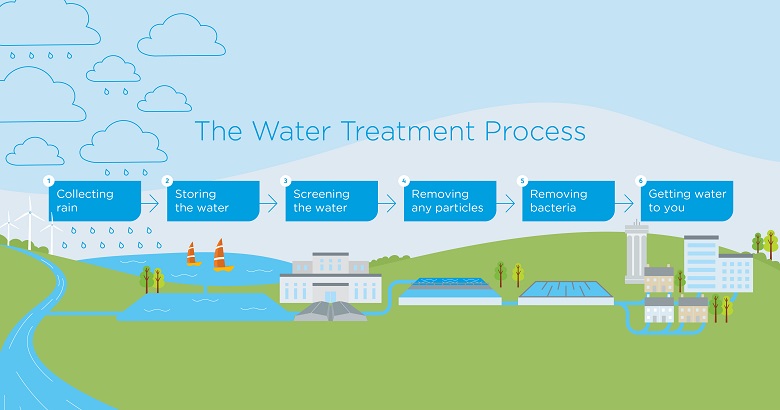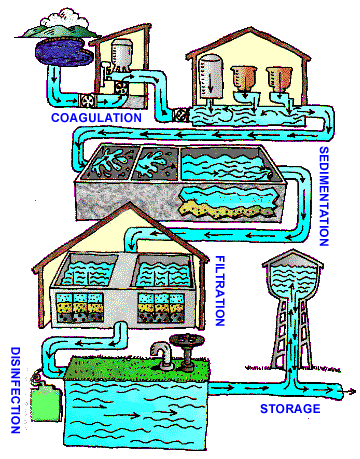Getting My Reverse Osmosis Filter For Home To Work
Table of ContentsReverse Osmosis Filter For Home - TruthsAbout Reverse Osmosis Filter For HomeAll about Reverse Osmosis Filter For HomeThe 25-Second Trick For Reverse Osmosis Filter For HomeNot known Facts About Reverse Osmosis Filter For HomeThe Of Reverse Osmosis Filter For Home
Coagulation When water goes into a treatment plant, the initial stage while doing so is coagulation where chemicals are included in the water system to enable microparticles and little solids to stick. Polyelectrolyte, ferrous sulfate, and also aluminum sulfate are examples of chemicals made use of in the water therapy plant process to aid coagulation.Quality requirements additionally need to be satisfied as component of the regulative processes within water therapy plants. Flocculation When water has actually been treated with the coagulation chemicals it goes into a tank with giant paddles.
Throughout this last stage water is passed through a filter in a regulated manner. Last Ideas on The Process of Water Purification in Water Plants The water filtration plant processes are crucial to maintaining a secure supply of water for public and also commercial usage.
Getting My Reverse Osmosis Filter For Home To Work

A thermal catalytic destruct system removes excess ozone gas and also limits the focus of ozone released to the environment. 3: Quick Mix (Coagulation) Throughout quick mix, light weight aluminum sulfate (alum) and also polymer are included and blended with the water to begin the coagulation process (the formation of globs from the penalty, suspended particles in the water).
4: Ballasted Flocculation (Actiflo) Ballasted flocculation combines the standard flocculation and also sedimentation processes to consist of the enhancement of a weighting or ballast material. Light suspended issue in the previously coagulated water is flocculated to develop larger particles. This floc then bonds to the ballast material or micro-sand to make sure that it may clear up out extremely quickly.
Reverse Osmosis Filter For Home Fundamentals Explained
5: Filtration Purification removes particle impurities and recurring floc from the water being treated. Great bits are infiltrated multi-media filters being composed of layers of anthracite and also sand. When the filters end up being obstructed with these bits, they are backwashed with filtered water. The backwashed water goes to a small package plant where it is partially-treated before returning to the head of the treatment procedure.
Water Treatment as well as Pathogen Removal, Water therapy is comprised of a variety of unit refines operated in collection with their selection dependent on raw water quality and also its seasonal irregularity (Table 30 (reverse osmosis filter for home). 2). Pre-treatment might be needed for water that is of very low quality particularly which is greatly infected with microbial microorganisms when it might be sanitized prior to traditional treatment.
Where the coliform matter is > 20 cfu 100 m, L1 then standard treatment of coagulation-sedimentation, filtration as well as post-chlorination is all that is needed. this link Some high pureness surface area and ground waters might have really low raw water coliform counts (
Reverse Osmosis Filter For Home Things To Know Before You Buy
After the floc has actually started absorption, it passes throughout a collection of baffles and mixed with straight paddles. The water proceeds on from the flocculation chambers to the sedimentation containers, where it is held while the floc, which now includes fairly large bits, about 3mm in size, begins to settle out and also sink to the base of the tank.
After the floc has actually started absorption, it passes across a collection of baffles and combined with straight paddles. The water continues from the flocculation chambers to the sedimentation tanks, where it is held while the floc, which currently includes fairly huge bits, about 3mm in size, starts to settle out and sink to the base of the tank - reverse osmosis filter for home.
After the floc has actually started absorption, it passes throughout a collection of baffles as well as mixed with straight paddles. The water advances from the flocculation chambers to the sedimentation containers, where it is held while the floc, which now contains rather large fragments, about 3mm in diameter, starts to clear up out and also sink to the bottom of the storage tank.
A Biased View of Reverse Osmosis Filter For Home
After the floc has begun absorption, it passes throughout a collection of baffles and also mixed explanation with horizontal paddles. The water advances from the flocculation chambers to the sedimentation tanks, where it is held while the floc, which now contains rather huge fragments, concerning 3mm in diameter, begins to clear up out and sink to the base of the storage tank.
After the floc has begun absorption, it passes throughout a series of baffles and mixed with horizontal paddles. reverse osmosis filter for home. The water continues on from the flocculation chambers to the sedimentation tanks, where it is held while the floc, which currently includes rather large fragments, about 3mm in diameter, starts to settle out and sink to the bottom of the container.

Rumored Buzz on Reverse Osmosis Filter For Home
After the floc has begun absorption, it passes throughout a series of baffles as well as combined with straight paddles. The water advances from the flocculation chambers to the sedimentation containers, where it is held while the floc, which currently is composed of rather big bits, concerning 3mm in diameter, begins to resolve out as well as sink to the bottom of the tank.